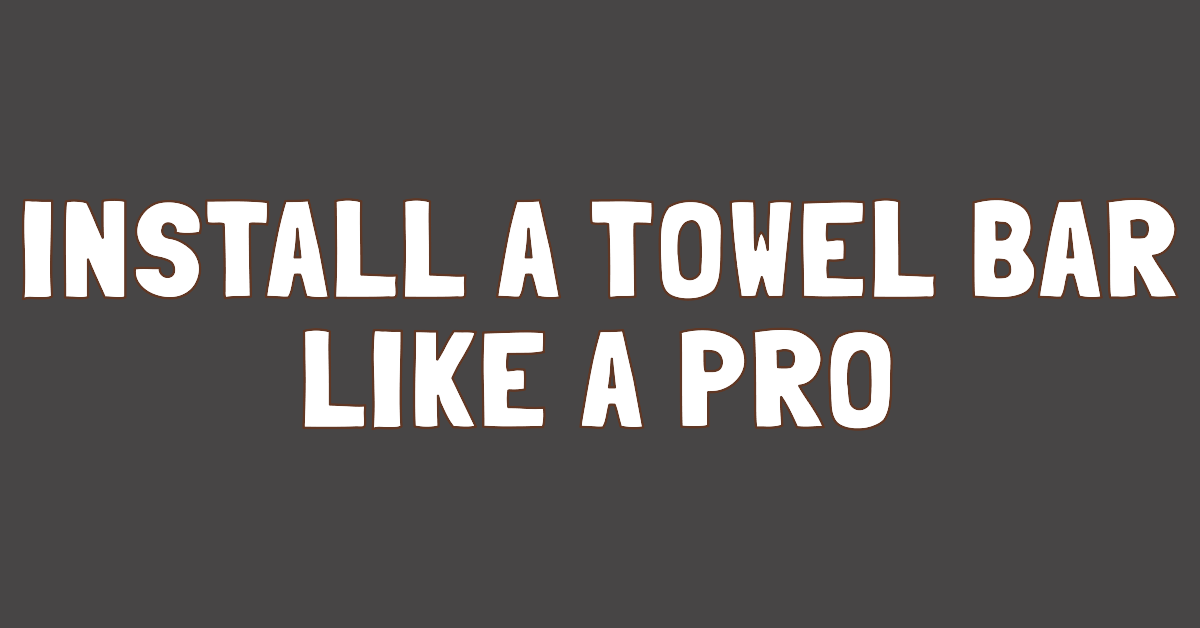When it comes to keeping your bathroom neat and easy to use, one of the most important things to have is a towel holder. Whether it’s for a small hand towel or a big bath towel, having a place to hang them up helps keep your bathroom organized and makes your daily routine smoother.
In this guide, we’ll show you how to install a towel bar in your bathroom, making sure it’s strong and looks good too.
Tools and Materials Needed
Here’s what you’ll need:
- Towel bar and mounting hardware
- Drill and drill bits
- Level
- Pencil
- Screwdriver
- Stud finder (optional)
- Drywall anchors (if not mounting to a stud)
- Hammer (if using drywall anchors)
Preparation

Once you have all your supplies ready, it’s time to choose the perfect spot to install your new towel bar.
The standard height recommendation is around 48 inches from the floor to the center of the bar. This puts towels within comfortable reach for most adults. However, feel free to adjust the height based on your personal needs or preferences.
It’s also important to measure for any potential obstructions. Make sure there is enough clearance from doors, windows, or other bathroom elements like light fixtures or cabinets. Allow a few inches of space on both sides of the towel bar as well.
Installation Process
Now that you’re prepared, let’s dive into the installation process step by step:
1. Marking the Wall
Start by using the towel bar or a provided template to mark the drilling locations on the wall. Use a pencil and a level to ensure that the markings are straight and aligned.
2. Drilling Pilot Holes
With the markings in place, use a drill and the appropriate drill bit size to drill pilot holes at each marked location. Pilot holes help prevent the wall from cracking and make it easier to insert screws or anchors during the mounting process.
3. Mounting the Brackets
The method of mounting the brackets will depend on your wall type:
- Mounting to studs: Use a stud finder to locate the studs behind the wall. Use a screwdriver to directly screw the brackets into the studs using the provided screws. Make sure the brackets are securely attached to the wall.
- Mounting to drywall: For drywall installation, use drywall anchors to provide additional support. Choose anchors suitable for the weight of the towel bar and towels, and insert them into the pre-drilled holes. Use a hammer to make sure they stay in place.
4. Attaching the Towel Bar
Once the brackets are securely mounted, it’s time to attach the towel bar. Simply slide the ends of the towel bar into the brackets and make sure it is straight before tightening any screws.

Tips for Successful Installation
To ensure a successful installation, consider the following tips:
- Avoid over-tightening screws and anchors into drywall to prevent damage.
- Double-check all measurements and levels before drilling to avoid costly mistakes.
- Select anchors that are appropriate for the weight of your towel bar to ensure a secure installation.
- Test bars with weight or shaking once installed to confirm brackets are tight.
Troubleshooting Common Issues
In case you encounter any issues during installation, here are some common troubleshooting scenarios and solutions:
- Uneven installation: If your towel bar ends up hanging unevenly, you can adjust the brackets or use shims to level it out.
- Loose towel bar: If the towel bar feels loose after installation, check the tightness of screws or anchors and tighten them as needed.
Conclusion
By following these step-by-step instructions, you can confidently install a towel bar in your bathroom. Don’t be afraid to try this DIY project on your own and feel good about doing a job well. Remember, a properly installed towel bar not only makes your daily routine more convenient but also gives your bathroom a nice, stylish look.
Frequently Asked Questions
Can I install a towel bar myself?
Yes, installing a towel bar is a relatively simple DIY project for most people. It typically requires basic tools and minimal experience. However, if you’re uncomfortable with drilling or using power tools, it’s always best to consult a professional.
What height should I install the towel bar at?
The standard height for a towel bar is 48 inches from the floor. However, you can adjust this height based on your needs and preferences. For example, if you have young children, you may want to install it lower so they can reach it easily.
What should I do if I can’t find studs to mount the towel bar?
If you can’t locate studs in your wall, you can use drywall anchors to securely mount the towel bar. These anchors are available at most hardware stores and come in various sizes to match the weight of your towel bar.
Can I install a towel bar on tile walls?
Yes, you can install a towel bar on tile walls. However, you’ll need to use a special drill bit designed for tile to avoid cracking or damaging the tiles.

